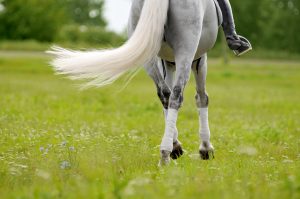This autumn is turning into an „Indian Summer“ with dry weather and sunshine. However this has resulted in ground conditions becoming hard. Hard ground can have a severe impact on your horse’s legs if not managed correctly; check out our advice on how best to manage and protect your horse.
Exercise
Adapting the weekly fitness regime to combat the ground conditions is essential for managing the impact of strain on your horse’s legs. Hard ground means that fitness regimes will have to be adapted to protect your horse from injury. The “warm up” is very important and becomes even more so with hard ground conditions. Initially, a gentle exercise is essential to begin with to slowly warm up the muscles and ligaments to increase elasticity and help reduce impact and strain on the legs. The exercise can be built up from there; however, you should be mindful of outside conditions (temperature, surface etc) when increasing exercise so as not to induce excess muscular strain. Equally important is the cool down period after exercise. This time allows your horse to relax and let down; it also gives time for the lactic acid in the muscles to decrease and reducing the risk of injury post exercise. Leg protection for your horse (such as boots or bandages) is a good idea during when the ground is hard as a precaution to further reduce the risk of a leg injury.
Exercise Aftercare
Firstly, remove any leg protection as soon as possible to allow the tendon temperature decrease to prevent injury. Best practise is to cold hose your horse’s legs for 5 minutes – recent studies have shown that cooling running water is more effective at cooling horses’ legs than ice. However, this option may not always be available (e.g. when out competing) sponging you horse’s legs thoroughly after exercise is an option. This is especially important if your horse has done fast work on hard ground (e.g. cross country). Another alternative is a clay or gel-based leg cooling product.
Cooling Gel
NutriBalm Cooling Gel from NutriScience works as when applied to your horse’s leg, it evaporates and carries away the heat therefore causing a cooling effect. It has been developed to facilitate the delivery of the active components of MSM, Arnica and Calendula to the point of action, unlike clays, which only work due to physical compress action. MSM has natural ‘cooling’ properties & can be utilised in the formation of disulfide bonds in the skin, connective tissue (ligaments, mucosal membranes, etc). Arnica is as a counter-irritant, which means that it produces a stimulating sensation that boosts circulation in the area where the arnica is applied. One of Arnica’s primary components, helenalin, also has a strong anti-endemic (anti-swelling) effect. Calendula has been used for centuries to soothe tired irritable legs.
For more advice and information, please contact our expert team on 051 304010




